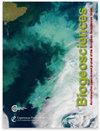小型海底峡谷对加拿大东部圣劳伦斯河口下游生物物质出口通量的影响
IF 3.9
2区 地球科学
Q1 ECOLOGY
引用次数: 0
摘要
摘要海底峡谷加强了陆架-陆坡沉积物交换并影响了水动力过程,从而对生物地球化学循环产生了影响。这项研究记录了圣劳伦斯河口下游(加拿大东部魁北克省)北岸生物源物质垂直输出的变化,该地区的特点是存在一个活跃的海底峡谷系统。2020 年 11 月至 2021 年 9 月期间,共部署了三个锚系设备。一个近岸锚系设备(PDMc)部署在 Pointe-Des-Monts(PDM)峡谷系统的主轴上,配备有声学多普勒海流剖面仪(ADCP);两个配备有沉积物捕集器的锚系设备分别部署在 PDM 远端峡谷系统(PDM-154、PDM-224)和 Baie-Comeau 近海(BC-133)。ADCP 数据显示,峡谷中出现了小规模沉积物再移动事件(2020 年 12 月)和小规模浊流(2021 年 2 月)。同时升高的总颗粒物、颗粒有机碳、颗粒氮和氯色素通量表明,这些事件通过加强再悬浮沉积物的横向扩散,在离岸 > 2.6 公里处的沉积物捕集器 PDM-154 和 PDM-224 中留下了痕迹。峡谷系统和不列颠哥伦比亚省近海的硅藻和甲藻群的组成相似,但 PDM 地点的硅藻藻华发生的时间要早两周(4 月中旬)。2021 年 9 月下半月,在 BC 点还观察到了可能有毒的硅藻 Pseudo-nitzschia seriata 的大量繁殖。PDM 地点的硅藻和甲藻年通量几乎是 BC 地点的 2 倍,这可能是由于河流输入和水体结构的不同,以及 PDM 地点沉积物输入和再悬浮的增加导致光照有限。这项研究明显有助于确定近床峡谷过程与水柱中生物物质输出之间的关系,从而直接影响 PDM 近海生态系统。研究期间还涵盖了一个异常的几乎无冰的冬季,因此,在气候变化的背景下,该研究为了解 LSLE 中生物物质输出的未来趋势提供了宝贵的见解。本文章由计算机程序翻译,如有差异,请以英文原文为准。
Influence of a small submarine canyon on biogenic matter export flux in the lower St. Lawrence Estuary, eastern Canada
Abstract. Submarine canyons enhance shelf–slope sediment exchange and influence hydrodynamic processes, with consequences for biogeochemical cycles. This work documents variations in the vertical export of biogenic matter on the northern shore of the lower St. Lawrence Estuary (LSLE, Quebec, eastern Canada), which is characterized by the presence of an active submarine canyon system. A total of three moorings were deployed from November 2020 to September 2021. One nearshore mooring (PDMc) was deployed in the main axis of the Pointe-des-Monts (PDM) canyon system and was equipped with an acoustic Doppler current profiler (ADCP), and two moorings equipped with sediment traps were deployed in the distal PDM canyon system (PDM-154, PDM-224) and offshore Baie-Comeau (BC-133). The ADCP data revealed the occurrence of a minor sediment remobilization event (December 2020) and a small turbidity current (February 2021) in the canyon. Concurrent elevated fluxes of total particulate matter, particulate organic carbon, particulate nitrogen, and chloropigments showed that these events left a signature in sediment traps PDM-154 and PDM-224 located > 2.6 km further offshore by enhancing lateral dispersion of resuspended sediments. The composition of diatom and dinoflagellate assemblages was similar in the canyon system and offshore BC, but the diatom bloom occurred 2 weeks earlier (in mid-April) at the PDM site. A bloom of the potentially toxic diatom Pseudo-nitzschia seriata was also observed during the second half of September 2021 at the BC site. Annual diatom and dinoflagellate fluxes were almost 2 times lower at the PDM site than at the BC site, possibly due to differences in riverine input and the structure of the water column, as well as increased sediment input and resuspension at the PDM site, leading to limited light availability. This study notably helps identify the relationship between near-bed canyon processes and biogenic matter export in the water column, thereby directly influencing the ecosystem offshore PDM. The study period further covered an anomalously nearly ice-free winter, and thus, in the context of climate change, it provides valuable insight into future trends of biogenic matter export in the LSLE.
求助全文
通过发布文献求助,成功后即可免费获取论文全文。
去求助
来源期刊

Biogeosciences
环境科学-地球科学综合
CiteScore
8.60
自引率
8.20%
发文量
258
审稿时长
4.2 months
期刊介绍:
Biogeosciences (BG) is an international scientific journal dedicated to the publication and discussion of research articles, short communications and review papers on all aspects of the interactions between the biological, chemical and physical processes in terrestrial or extraterrestrial life with the geosphere, hydrosphere and atmosphere. The objective of the journal is to cut across the boundaries of established sciences and achieve an interdisciplinary view of these interactions. Experimental, conceptual and modelling approaches are welcome.
 求助内容:
求助内容: 应助结果提醒方式:
应助结果提醒方式:


